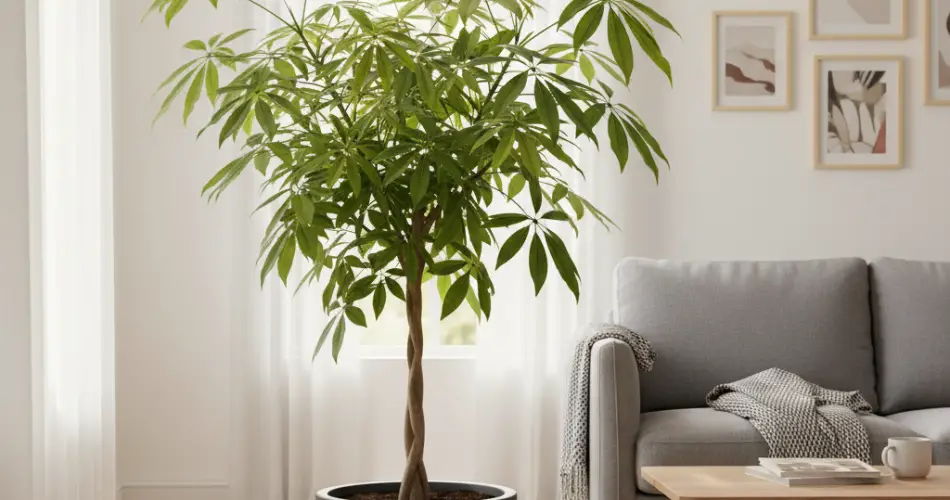The umbrella tree (Schefflera arboricola), also known as dwarf umbrella tree or schefflera, is a popular indoor plant admired for its glossy, umbrella-like leaf clusters and vibrant green foliage. Its attractive appearance and adaptability make it a favorite for homes and offices. However, like any plant, its health and growth largely depend on proper care, with sunlight being one of the most critical factors. Understanding how much sunlight an umbrella tree needs indoors can help it thrive and maintain its lush, attractive foliage.
Understanding Umbrella Tree Light Requirements
Native to Taiwan and Hainan, the umbrella tree naturally grows in tropical and subtropical regions under the canopy of larger trees. In its natural habitat, it receives bright, filtered sunlight, rather than direct exposure to intense rays. This explains why umbrella trees are well-suited for indoor environments and can tolerate a range of lighting conditions, from low to bright indirect light. However, the plant thrives best when placed in conditions that mimic its natural filtered-light environment.
Ideal Sunlight for Indoor Umbrella Trees
Umbrella trees perform best in bright, indirect light. Placing the plant near an east-facing window is often ideal, as it receives soft morning sunlight that promotes healthy growth without risking leaf burn. South- or west-facing windows can also work, but the light should be filtered through a sheer curtain to prevent direct exposure. Umbrella trees can tolerate lower light levels, making them suitable for offices or rooms with limited window access. However, insufficient light over time may slow growth, reduce leaf vibrancy, and cause the plant to become leggy as it stretches toward the light source.
Signs of Too Much Sunlight
Although umbrella trees enjoy bright light, too much direct sunlight can damage the plant. Signs of excessive light include yellowing leaves, brown leaf tips, scorched foliage, and curling leaves. Prolonged exposure to intense sunlight can stress the plant, stunt growth, and even cause permanent leaf damage. If these symptoms appear, move the umbrella tree to a location with filtered or indirect sunlight or use a sheer curtain to diffuse the light.
Signs of Too Little Sunlight
Umbrella trees are adaptable and can survive in low-light conditions, but insufficient light over time can lead to several issues. Growth may slow significantly, leaves may turn pale, and the plant may become sparse or leggy. In extreme cases, older leaves may drop as the plant conserves energy. While umbrella trees tolerate dim lighting temporarily, consistent bright, indirect light ensures healthier, fuller foliage and maintains its natural vibrant green color.
Balancing Light with Other Care Factors
Sunlight is one factor in umbrella tree care, but overall plant health also depends on watering, humidity, and soil quality. These trees prefer well-draining soil and moderate watering; overwatering in low-light conditions can cause root rot, while intense sunlight combined with dry indoor air can dry out foliage. Maintaining a balance of light, moisture, and humidity ensures the umbrella tree remains lush and resilient.
Using Artificial Lighting Indoors
In indoor environments with limited natural light, umbrella trees benefit from fluorescent or LED grow lights. Position the light about 12–18 inches above the plant and run it for 12–14 hours daily to replicate natural sunlight. Artificial lighting is particularly useful in rooms with minimal window access or during winter months when daylight is short, helping maintain vibrant foliage and steady growth.
Monitoring and Adjusting Your Umbrella Tree
Regular observation is essential to keeping an umbrella tree healthy. Yellowing, browning, or stretched leaves may indicate the need for light adjustment. Rotating the plant every few weeks ensures all leaves receive even light, preventing lopsided growth and encouraging a symmetrical, full appearance.
Choosing the Right Indoor Location
Optimal locations for indoor umbrella trees include:
-
Near east-facing windows for gentle morning sunlight.
-
Near south- or west-facing windows with filtered light through a sheer curtain.
-
Bright rooms with indirect light from multiple directions.
Avoid placing the plant in harsh direct sunlight or near heat sources, air conditioners, or drafty areas, as these conditions can stress the plant and damage foliage.
Conclusion
Umbrella trees are versatile, adaptable indoor plants that thrive in bright, indirect sunlight. Too much direct sun can scorch leaves, while too little light slows growth and diminishes leaf vibrancy. By positioning your plant near the appropriate light source, supplementing with artificial lighting if necessary, and balancing sunlight with proper watering and humidity, your umbrella tree can thrive indoors. Its lush, umbrella-like foliage, low-maintenance care, and tropical appeal make it an attractive addition to any indoor environment, enhancing both aesthetics and indoor air quality.



